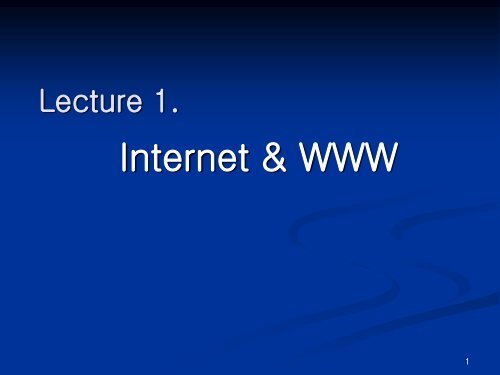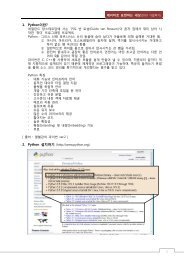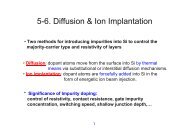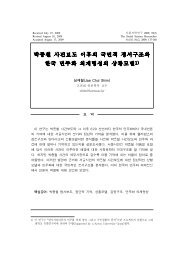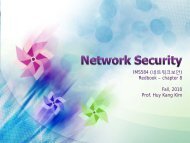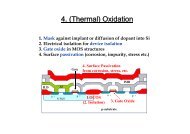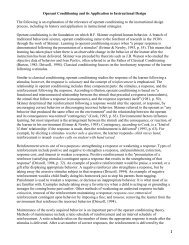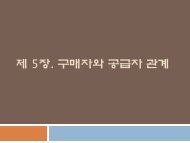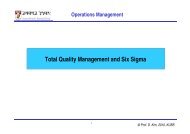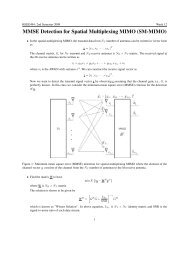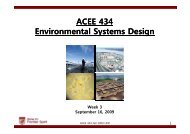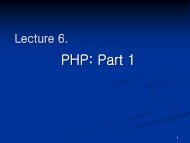Create successful ePaper yourself
Turn your PDF publications into a flip-book with our unique Google optimized e-Paper software.
Lecture 1.Internet & WWW1
Computer Network• A computer network is a system for communicationbetween computers.• These networks may be fixed (cabled, permanent) ortemporary (as via modems or null modems)• Wireless internet generally works over wifi or cellularcarrier's networks• LAN (Local Area Network) is a computer networkcovering a small local area such as office• WAN (Wide Area Network) is a computer networkcovering a wide geographical area such as building2
Communication Pro<strong>to</strong>col• A set of standard rules for data representation, signaling,au<strong>the</strong>ntication, and error detection required <strong>to</strong> sendinformation over a communications channel• TCP/IP (Transmission Control Pro<strong>to</strong>col / Internet Pro<strong>to</strong>col)• FTP (File Transfer Pro<strong>to</strong>col)• SMTP (Simple Mail Transfer Pro<strong>to</strong>col)• HTTP (Hyper Text Transfer Pro<strong>to</strong>col)• PPP (Peer-<strong>to</strong>-Peer Pro<strong>to</strong>col)• SLIP (Serial Line Internet Pro<strong>to</strong>col)3
A Brief Intro <strong>to</strong> <strong>the</strong> Internet• Origins: ARPAnet• Late 1960s and early 1970s• Funded by DoD‟s Advanced Research Projects Agency• Focused on <strong>the</strong> network reliability (robustness)• Connecting ARPA-funded research organizations only• BITNET, CSNET - late 1970s & early 1980s• email and <strong>file</strong> transfer for o<strong>the</strong>r institutions• Because It‟s Time Network / Computer Science Network• BITNET began at <strong>the</strong> City <strong>University</strong> of New York• Could not become a dominant national network4
A Brief Intro <strong>to</strong> <strong>the</strong> Internet• NSFnet - 1986• Sponsored by National Science Foundation (NSF)• Initially connected <strong>the</strong> NSF-funded supercomputer centers• Soon, available <strong>to</strong> academic institutions /research labs• By 1990, it had replaced ARPAnet for non-military uses• Soon became <strong>the</strong> network for all (by <strong>the</strong> early1990s)• In 1995, a small part of NSFnet as research network• The rest eventually became known as <strong>the</strong> Internet5
A Brief Intro <strong>to</strong> <strong>the</strong> Internet• Domain names• IP address in <strong>the</strong> textual form ra<strong>the</strong>r than numbers• Host machine name followed by domain names• First domain is <strong>the</strong> smallest; last is <strong>the</strong> largest• Last domain specifies <strong>the</strong> type of organizationex) In <strong>the</strong> U.S. com for companygov for governmentedu for educational institutionsO<strong>the</strong>rwise, country name such as .kr for KOREA• Fully qualified domain name - <strong>the</strong> host name and all of<strong>the</strong> domain namesex) movies.comedy.marxbros.com8
A Brief Intro <strong>to</strong> <strong>the</strong> Internet• Fully qualified domain names and IP addresses areequivalent• IP address and Domain Name are 1:1• IP address: numbers only, difficult <strong>to</strong> remember• Domain Name: text, easy <strong>to</strong> remember• Their conversions are done by software systemscalled name servers• Domain Name System (DNS) server9
Domain NameWebServerDomainNameInternetDomainNameInternetIPAddressIPAddressNameServer10
Domain Name• By <strong>the</strong> mid-1980s, several different pro<strong>to</strong>cols had been invented and were being used on <strong>the</strong> Internet (Telnet, FTP, Usenet, mail<strong>to</strong>)=> Users should learn all <strong>the</strong> different user interfaces• A possible solution <strong>to</strong> <strong>the</strong> proliferation of differentpro<strong>to</strong>cols being used on <strong>the</strong> Internet=> World Wide Web• World Wide Web: Internet-based hypermedia initiativefor global information sharing11
The World-Wide Web• Origins• Proposed by Tim Berners-Lee et al at CERN in 1989,who wrote <strong>the</strong> first web client and server in 1990• Allow scientists <strong>to</strong> use <strong>the</strong> Internet <strong>to</strong> exchangedocuments describing <strong>the</strong>ir work• Documents have a form of hypertext• Use embedded links <strong>to</strong> access o<strong>the</strong>r documents fornon-sequential browsing• Unit of information: Pages / Documents / Resources• Hypermedia – when a document contains more than justtext – images, sound, etc.* CERN: <strong>the</strong> European Particle Physics Labora<strong>to</strong>ry12
WWW (World Wide Web)• Web or Internet?• The Internet is a collection of computers and o<strong>the</strong>rdevices connected by equipment <strong>to</strong> communicate• The Web is a collection of software and pro<strong>to</strong>cols thathas been installed on most computers on <strong>the</strong> Internet• Global information space which people can read andwrite via computers connected <strong>to</strong> <strong>the</strong> Internet.• World Wide Web is combination of four ideas :• Hypertext• Resource identifiers• Client-server architecture• Markup language13
WWW (World Wide Web)• Hypertext, that is <strong>the</strong> ability, in a computer environment, <strong>to</strong>move from one part of a document <strong>to</strong> ano<strong>the</strong>r or from onedocument <strong>to</strong> ano<strong>the</strong>r through internal connections among<strong>the</strong>se documents (called "hyperlinks");• Resource identifiers, that is <strong>the</strong> ability, on a computernetwork, <strong>to</strong> locate a particular resource (computer,document or o<strong>the</strong>r resource) on <strong>the</strong> network through aunique identifier;• The client-server model of computing, in which clientsoftware or a client computer makes requests of serversoftware or a server computer that provides <strong>the</strong> client withresources or services, such as data or <strong>file</strong>s; and• Markup language, in which characters or codes embeddedin text indicate <strong>to</strong> a computer how <strong>to</strong> print or display <strong>the</strong>text, e.g. as in italics or bold type or font.14
WWW (World Wide Web)• Send and retrieve multimedia documents including text,images, graphs, sounds, and video• Web Browser• Client program for viewing Hypertext document• GUI (Graphic User Interface)• Contributed <strong>to</strong> booming up <strong>the</strong> web• HTML (Hyper Text Markup Language)• A set of pre-defined tags• WYSIWYG(What You See Is What You Get) authoring <strong>to</strong>ol• SGML (Standard Generalized Markup Language)• HTTP (Hyper Text Transfer Pro<strong>to</strong>col) : pro<strong>to</strong>col forsending/receiving HTML documents15
Web Browsers• Client program for viewing Hypertext documents• Mosaic - NCSA (Univ. of Illinois), in early 1993• First <strong>to</strong> use a GUI, led <strong>to</strong> explosion of Web use• Initially for X-Windows, under UNIX, but was ported <strong>to</strong>o<strong>the</strong>r platforms by late 1993• Browsers are clients - always initiate, servers react(although sometimes servers require responses)• Most requests are for existing documents, usingHypertext Transfer Pro<strong>to</strong>col (HTTP)• But, some requests are for program execution, with<strong>the</strong> output being returned as a document• Internet Explore / Netscape / Mosaic / FireFox16
Web Servers• Web servers are programs that provide documents <strong>to</strong>requesting browsers• Slave program in that <strong>the</strong>y act only when requests aremade <strong>to</strong> <strong>the</strong>m• Apache• <strong>the</strong> most commonly used web servers• takes 59% over 110 million web hosts as of March 2007• Microsoft‟s Internet Information Server (IIS)• runs under Windows OS• takes 31%17
Web Server Operation• Provide responses <strong>to</strong> browser requests, ei<strong>the</strong>r existingdocuments or dynamically built documents• Browser-server connection is now maintained throughmore than one request-response cycle• All communications between browsers and serversuse Hypertext Transfer Pro<strong>to</strong>col (HTTP)• Web servers run as background processes in <strong>the</strong>operating system• Moni<strong>to</strong>r a communications port on <strong>the</strong> host, acceptingHTTP messages when <strong>the</strong>y appear18
Web Server OperationsSummarizing1. Moni<strong>to</strong>r a communications port on its host machine2. Accept HTTP commands through that port3. Perform <strong>the</strong> operations of <strong>the</strong> commands4. Send <strong>the</strong> output <strong>to</strong> <strong>the</strong> requesting client• HTTP commands include a URL, which can specifyone of two different things• <strong>the</strong> address of a data <strong>file</strong> on <strong>the</strong> server• a program s<strong>to</strong>red on <strong>the</strong> server that <strong>the</strong> client wantsexecuted19
General Server Characteristics• All web servers have a common ancestry• <strong>the</strong> server developed at CERN in Europe• <strong>the</strong> server developed at NCSA at <strong>the</strong> Univ. of Illinois• Two separate <strong>file</strong> direc<strong>to</strong>ries• Document direc<strong>to</strong>ry s<strong>to</strong>res <strong>the</strong> Web documents• Server direc<strong>to</strong>ry s<strong>to</strong>res <strong>the</strong> server and its support software• Typically, clients do not access <strong>the</strong> document rootdirectly in URLs => use direc<strong>to</strong>ry mapping• Virtual hosts: secondary hosts when servers cansupport more than one site on a computer• Proxy servers: when servers can serve documents in <strong>the</strong>document root of o<strong>the</strong>r machines on <strong>the</strong> Web20
Virtual Hosts SettingServer IP : 192.168.10.120Domains: www.linux.com at /usr/local/apache/htdocswww.flower.com at /home/flower/public_html1. Put <strong>the</strong> following in<strong>to</strong> /etc/hosts192.168.10.120 www.linux.com192.168.10.120 www.flower.com2. Put <strong>the</strong> following in<strong>to</strong> httpd.confNameVirtualHost 192.168.10.120ServerAdmin webmaster@linux.comDocumentRoot /usr/local/apache/htdocsServerName www.linux.com...ServerAdmin flower@linux.comDocumentRoot /home/flower/public_htmlServerName www.flower.com...21
Apache Server• began as <strong>the</strong> NCSA server, httpd, with some addedfeatures• has nothing <strong>to</strong> do with <strong>the</strong> native American tribe• named from “a patchy version of <strong>the</strong> httpd server”• reasons for its popularity• fast and reliable• open-source software• best available server for Unix-based systems• httpd.conf: configuration <strong>file</strong> that s<strong>to</strong>res directives <strong>to</strong>control an Apache server‟s behavior• details at http://httpd.apache.org/docs/2.2/mod/quickreference.html• ported <strong>to</strong> <strong>the</strong> Windows platform22
Service DirectivesDirective NameServerNameServerRootServerAdminDocumentRootAliasRedirectDirec<strong>to</strong>ryIndexUserDirPurposeNames <strong>the</strong> server systemPath <strong>to</strong> <strong>the</strong> server rootThe site administra<strong>to</strong>r‟s addressPath <strong>to</strong> <strong>the</strong> document rootThe document root‟s virtual and physical pathsA pointer <strong>to</strong> a document or document direc<strong>to</strong>ry ona different serverNames of <strong>the</strong> welcome pagesSpecifies whe<strong>the</strong>r local users can add/deletedocuments23
IIS (Internet Information Server)• supplied as part of Windows OS• shows reasonably good performance most Windows-based Web servers use this• Apache and IIS provide similar varieties of services• Difference in <strong>the</strong> view of site manager• Apache controlled by a configuration <strong>file</strong>• IIS controlled by a window-based management programcalled IIS snap-in24
URL (Uniform Resource Loca<strong>to</strong>r)• Used <strong>to</strong> identify documents (resources) on <strong>the</strong> Internet• URL format: scheme:object-address• The scheme is often a communication pro<strong>to</strong>col(Ex) http, ftp, gopher, telnet, <strong>file</strong>, mail<strong>to</strong>, news• In <strong>the</strong> case of HTTP, <strong>the</strong> object address is//Domain Name/document path/document name (or IP Address)Ex) http://www.naver.com• The hostname is <strong>the</strong> name of <strong>the</strong> server computer thats<strong>to</strong>res <strong>the</strong> document• Messages <strong>to</strong> a host machine must be directed <strong>to</strong> <strong>the</strong>appropriate process on <strong>the</strong> host for handling, which isidentified by <strong>the</strong> port number• The default port number of Web server process is 8025
URL• URLs cannot include spaces or any of a collection ofo<strong>the</strong>r special characters (semicolons, colons, &, ...)• To include <strong>the</strong>m, <strong>the</strong> character must be coded as a %followed by its hexadecimal ASCII code(Ex) San Jose for domain name San%20Jose• The doc path may be a complete path or abbreviatedas a partial path• A partial path is relative path <strong>to</strong> some base pathspecified in <strong>the</strong> configuration <strong>file</strong>• The rest is furnished by <strong>the</strong> server configuration(Ex) http://www.gum.com/<strong>file</strong>s/f99/map.html= http://www.gun.com/map.html with root direc<strong>to</strong>ry<strong>file</strong>s/f99 in <strong>the</strong> configuration <strong>file</strong>.26
URL• If <strong>the</strong> doc path ends with a slash, it means a direc<strong>to</strong>ry,not a single <strong>file</strong>(Ex) http://www.gumboco.com/departments/• If a direc<strong>to</strong>ry is specified with no name as in(Ex) http://www.gumboco.com/The server searches at <strong>the</strong> <strong>to</strong>p level of <strong>the</strong> direc<strong>to</strong>ry inwhich servable documents are normally s<strong>to</strong>red forsomething it recognizes as ( home page ).index.html• By convention, this <strong>file</strong> is named as ( ).• If no home page found, a direc<strong>to</strong>ry listing isconstructed and returned <strong>to</strong> <strong>the</strong> browser.27
Multipurpose Internet Mail Extensions (MIME)• Originally developed for email• Used <strong>to</strong> specify <strong>to</strong> <strong>the</strong> browser <strong>the</strong> form of a <strong>file</strong>returned by <strong>the</strong> server (attached by <strong>the</strong> server <strong>to</strong> <strong>the</strong>beginning of <strong>the</strong> document)• Type specifications: type/subtype• Ex: text/plain, text/html, image/gif, image/jpeg• The most common MIME types: text, image, video• Server <strong>get</strong>s type from <strong>the</strong> requested <strong>file</strong> name‟s suffix• Ex) .html implies text/html• Browser <strong>get</strong>s <strong>the</strong> type explicitly from <strong>the</strong> server28
HyperText Transfer Pro<strong>to</strong>col (HTTP)• The pro<strong>to</strong>col used by ALL Web communications• Its complete specs available at http://www.w3.org• HTTP consist of two phases: Request and Response• Each communication consists of a header and a body• Header contains information about <strong>the</strong> communication• Body contains <strong>the</strong> data of <strong>the</strong> communication• General form of an HTTP Request1. HTTP method domain part of <strong>the</strong> URL HTTP ver.2. Header fields3. Blank line4. Message body(Ex) GET /cs.uccp.edu/degrees.html HTTP/1.129
Request Methods• Most commonly used methods:• GET – Fetches <strong>the</strong> contents of <strong>the</strong> specified document• POST - Executes <strong>the</strong> document, using <strong>the</strong> data in body• HEAD - Fetches just <strong>the</strong> header info. of <strong>the</strong> document• PUT – Replaces <strong>the</strong> document with <strong>the</strong> data in body• DELETE - Removes <strong>the</strong> document from <strong>the</strong> server• GET and POST are <strong>the</strong> most frequently used.• POST was originally for posting a news article <strong>to</strong> anewsgroup.• Its common use now is <strong>to</strong> send form data <strong>to</strong> <strong>the</strong> server,along with a request <strong>to</strong> execute a program on <strong>the</strong> server<strong>to</strong> process <strong>the</strong> form data30
HyperText Transfer Pro<strong>to</strong>col• Four categories of header fields:1. General: For general info. such as <strong>the</strong> date2. Request: Included in request headers3. Response: For response headers4. Entity: Used in both request and response headers• Common request field is accept, which specifies apreference of <strong>the</strong> browser for <strong>the</strong> MIME type of <strong>the</strong>requested document.Accept: text/plainAccept: image/gifAccept: text/htmlAccept: text/*• If <strong>the</strong> request has a body, <strong>the</strong> body length must begiven with a Content-length field.Content-length: 488Content-type: text/html31
Request with GET methodGET /cgi-bin/form1?srch=dogfish&srvr=Canada HTTP/1.0Accept: text/plain..........User-Agent:NCSA Mosaic for X-Win/2.4 libwww/2.12 modified/* blank line/* empty body32
Request with POST methodPOST /cgi-bin/form1 HTTP/1.0Accept: text/plain..........User-Agent:NCSA Mosaic for X-Win/2.4 libwww/2.12 modifiedContent-type: application/x-www-form-urlencodedContent-length: 24/* blank linesrch=dogfish&srvr=Canada33
HyperText Transfer Pro<strong>to</strong>col• Can communicate with HTTP server without a browser/* creates a connection <strong>to</strong> <strong>the</strong> http port on <strong>the</strong>blanca.uccs.edu server> telnet blanca.uccs.edu http/* <strong>the</strong> server responds withTrying 128.198.162.60 ...Connected <strong>to</strong> blancaEscape character is „^]‟./* after connection, can give any http commandsGET /respond.html HTTP/1.1Host: blanca.uccs.edu34
Response Phase• General Form:1. Status line2. Response header fields3. blank line4. Response body• Status line format:HTTP version status code explanation(Ex) HTTP/1.1 200 OK (Current version is 1.1)404 Not Found /* <strong>file</strong> was not found200 OK /* handled without error500 /* encounter a problem35
Status code• Status code is a three-digit number; first digit specifies<strong>the</strong> general status1 => Informational2 => Success3 => Redirection4 => Client error5 => Server error36
HTTP Example• The essential header field is Content-type• An example of a complete response header:HTTP/1.1 200 OKDate: Tues, 18 May 2004 16:45:13 GMTServer: Apache (Red-Hat/Linux)Last-modified: Tues, 18 May 2004 16:38:38 GMTEtag: "841fb-4b-3d1a0179"Accept-ranges: bytesContent-length: 364Connection: closeContent-type: text/html, charset=ISO-8859-137
Toolbox• Client-side• XTHML: markup language• XML: meta-markup language• JavaScript: programming language• Java• Server-side• Perl, PHP, Ruby: programming languages• Java• Web technology• AJAX: uses JavaScript and XML38
Toolbox: XHTML• To describe <strong>the</strong> general form and layout of documents• An XHTML document is a mix of content and controls• Controls are tags and <strong>the</strong>ir attributes• Tags often delimit content and specify something abouthow <strong>the</strong> content should be arranged in <strong>the</strong> document• Attributes provide additional information about <strong>the</strong> tagcontent• His<strong>to</strong>ry• XHTML1.0 introduced in early 2000 by <strong>the</strong> W3C(www.w3c.org)• Alternative <strong>to</strong> HTML 4.01• Same except stronger syntactic rules• XHTML 2.0 in May 200139
Toolbox: XHTML• Tools for creating XHTML documents• XHTML edi<strong>to</strong>rs• make document creation easier• Shortcuts <strong>to</strong> typing tag names, spell-checker,syntax-checker• WYSIWYG XHTML edi<strong>to</strong>rs• Need not know XHTML <strong>to</strong> create XHTML documents• MS FrontPage, Macromedia Dreamweaver, AdobePageMill• Plug ins: Integrated in<strong>to</strong> <strong>to</strong>ols like word processors,effectively converting <strong>the</strong>m <strong>to</strong> WYSIWYG XHTMLedi<strong>to</strong>rs• Filters: Convert documents in o<strong>the</strong>r formats such asLaTex or Word <strong>to</strong> XHTML40
XHTML Example• image.html• line.html41
Toolbox: XML• A meta-markup language• Used <strong>to</strong> create a new markup language for a particularpurpose or area• Because <strong>the</strong> tags are designed for a specific area,<strong>the</strong>y can be meaningful• No presentation details• A simple and universal way of representing data ofany textual kind42
XML ExampleEveryday ItalianGiada De Laurentiis200530.00Harry PotterJ K. Rowling200529.9943
Toolbox: JavaScript• A client-side XHTML-embedded scripting language• Its primary usage is(i) <strong>to</strong> validate form data and(ii) <strong>to</strong> create dynamic XHTML documents• Only related <strong>to</strong> Java through syntax• Dynamically typed and not object-oriented* C++ and Java: Strongly typed languages• Provides a way <strong>to</strong> access elements of HTMLdocuments and dynamically change <strong>the</strong>m44
JavaScript ExampleGrocery Menu - milk, bread, eggs, cheeseWith size = 1 (<strong>the</strong> default) milk bread eggs cheese 45
JavaScript Example The onLoad event handler> Microsoft Internet Explorer!You are visiting <strong>the</strong> home page ofPete‟s Pickled PeppersWELCOME!!!OK46
PHP Example…. Buyer's Name: Unpopped Popcorn (1 lb.) $3.00 47
Welcome <strong>to</strong> Millennium Gymnastics Booster Club Popcorn SalesBuyer’s Name:Street Address:City, State, Zip:Joe Popcorn123 Popcorn LanePopcorn City, Iowa, 22222Product Price QuantityUnpopped Popcorn(1 lb.) $3.00 3Caramel Popcorn(2 lb. canister) $3.50Caramel Nut Popcorn(2 lb. canister) $4.50 4Toffey Nut Popcorn(2 lb. canister) $5.00 5Payment MethodVisaMaster CardDiscoverCheckSubmit OrderClear Order Form48
Toolbox: Java• General purpose object-oriented programminglanguage• Based on C++, but simpler and safer• Our focus is on applets, servlets, and JSP49
Toolbox: Perl• Provides server-side computation for HTMLdocuments, through CGI• Perl is good for CGI programming because:• Direct access <strong>to</strong> operating systems functions• Powerful character string pattern-matching operations• Access <strong>to</strong> database systems• Perl is highly platform independent, and has beenported <strong>to</strong> all common platforms• Perl is not just for CGI50
Toolbox: PHP• A server-side scripting language• An alternative <strong>to</strong> CGI• Similar <strong>to</strong> JavaScript• Great for form processing and database accessthrough <strong>the</strong> Web51
PHP Example powers.php Powers table Number Square Root Square Cube Quad 52
PHP Example
ResultPowers tableNumber Square Root Square Cube Quad1 1 1 1 12 1.4142125623731 4 8 163 1.7320508075689 9 27 814 2 16 64 256567891054
Home page, Web page, Web site.• Terminology• Home page / Web page / Web siteHome pageWeb siteWeb page Web page Web pageWeb PageWeb page Web page Web pageWeb page Web page Web page55
Fundamentals of Web page design• Attractive web sites are also profitable• Banner ad.• High quality contents and artistic beauty• Components of web page• Header: determines first impression• Body: contains actual contents• Footer: update date, e-mail address, copyright, counter• Banner ads are usually located in <strong>the</strong> header or footer56
Bad web sites• No purpose or Poor contents• A few pho<strong>to</strong>s in <strong>the</strong> personal home page, or• Greeting from CEO in <strong>the</strong> enterprise home page.• Poor consideration for diverse users• Tremendous loading time• 10 second‟s rule• Strange usage of colors• Misc.• Script error• Strange plug-in• Many “under construction”s57
Fac<strong>to</strong>rs for good web sitesCorrectness Reliability MaintenancePortabilityWebSiteSecurityFriendliness Worth Extension58
Creating Web Site (1)• Purpose of a web site• Personal home page• Enterprise advertising• Providing information• E-commercial• Internet service• Design fac<strong>to</strong>rs• Business: objection and goal, client, work, interaction• Contents: application/<strong>the</strong>ory, information/entertainment• System: DB and system performance, Maintenance59
Creating Web Site (2)• Choose tar<strong>get</strong>: Representation and contents• S<strong>to</strong>ry Board• Brain s<strong>to</strong>rming• Classifying contents based on Site Map or Flow Chart• Creating web page draft on <strong>the</strong> paper• Creating web pages• Using HTML or WYSIWYG authoring <strong>to</strong>ol• Preparing related images• Creating web pages• Establishing links among pages60
User interface and search mechanisms• How <strong>to</strong> present <strong>to</strong> users: determine connections of pages• Should be designed for users• Web site searchHOMEHOMELinearHOMEMesh Hierarchy Linear + Hierarchy61
Search mechanisms• Text + bullet• Common but<strong>to</strong>ns• Image Map• Site Map• Remote control window• Metaphor• Graphic symbol or symbolic imagemetaphor62
Site maps• Sitemaps are an easy way for webmasters <strong>to</strong> informsearch engines about pages on <strong>the</strong>ir sites that areavailable for crawling. In its simplest form, a Sitemapis an XML <strong>file</strong> that lists URLs for a site along withadditional metadata about each URL (when it was lastupdated, how often it usually changes, and howimportant it is, relative <strong>to</strong> o<strong>the</strong>r URLs in <strong>the</strong> site) sothat search engines can more intelligently crawl <strong>the</strong>site.63
Site map example64
Web Page components• Various text format• Graphic text• Text format in <strong>the</strong> page• List, Enumeration• Table• Space-conscious placement• Use of Frame65
Principle of Web Page design• Home page downloading in 10 seconds• Update Frequently• Avoid any confusing links• Design overall web structure easily• Design <strong>to</strong> traverse among pages easily• Site links using relative path• Avoid excessive use of animation/graphic• Avoid emphasizing minor items• Avoid excessive use of frames66
For Better Web Page• Web page titles should be meaningful• Use of preview images• Web pages should be intended for generalenvironment• Web pages should be created for users• Long downloading should be with a warning message• Links within a sentence should be avoided67


